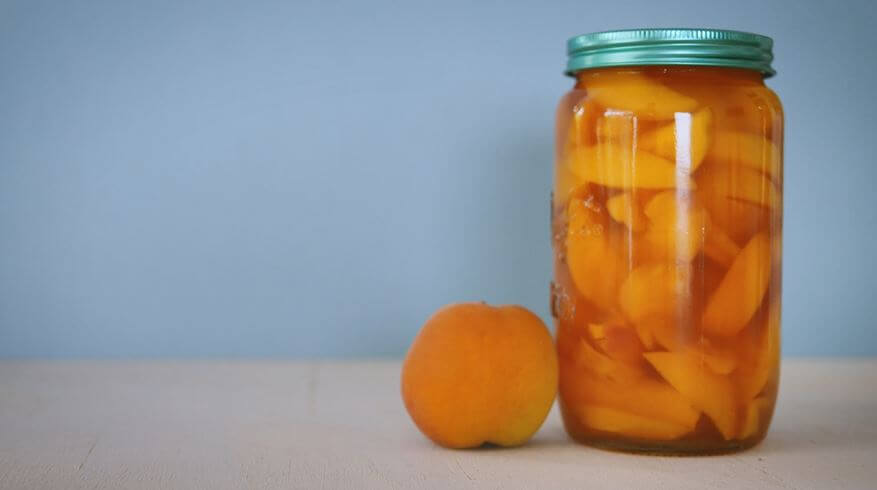How to bottle fruit

Bottling fruit may seem old-fashioned, but with so many fruit trees flourishing in Kiwi backyards, it is still an excellent and easy way of preserving fruit.
In New Zealand, the traditional method for bottling fruit is the “overflow” method (outlined below). This is different to the canning method where the full jars are simmered in boiling water.
The overflow method can be used for most kinds of fruit but can’t be used for bottling vegetables. The overflow method is designed to ensure that there is no air left in the jar, as it is air which can cause the fruit to go mouldy.
In order to bottle fruit you need to use preserving jars (e.g. Agee jars) – these are strong glass jars that are sealed using lids and rings. These can be purchased at your local supermarket. Op shops are great sources of Agee jars or they can be bought online from Trade Me.
Firm fruit which is not fully ripe is best for bottling. Sugar syrup is used to add flavour, rather than as a preservative. It is possible to use a lighter syrup and reduce the sugar or even use water with no sugar at all, though if you do this then you will need to eat it up quickly once opened.
Step-by-step guide
1. Wash your jars in very hot water and then place the jars in the oven at 120⁰C for 15-20 minutes. Pour boiling water over the seals and rings and leave to cool. Note: you can reuse the rings and jars but you can’t reuse the seals.
2. Wash your fruit. If necessary, peel your fruit (apples and feijoas should be peeled, but other fruits don’t need to be). Slice the washed fruit and discard the stones. 12 peaches would fill approximately 2 large Agee jars.
Tip: If you want to remove peach skins, plunge the whole fruit into boiling water for a minute or two and then peel when cool.
3. Make a light syrup by dissolving 1 cup of sugar in 3 cups of hot water in a large saucepan or preserving pan. Bring to boil and then boil for a few minutes. This should be enough for several large jars. Note: you can adjust the sugar ratio to determine the strength of the syrup. If you would like a heavier syrup, use a 1:1 sugar to water ratio.
4. Add your fruit to the hot syrup and cook gently until just tender. How long this will take depends on how ripe the fruit is, but peaches would take approximately 10-20 minutes. Test regularly. You don’t want to overcook the fruit as it will have hot syrup poured over it so it will continue to cook a little bit more once in the jar.
5. Once your fruit is ready, you need to work quickly to fill your jars while everything is still hot. Place a sterilised jar on a wooden or heatproof board and using a slotted spoon and a wide-necked funnel, fill the jar with your fruit. Note: it is safer to fill and seal the jars one at a time, leaving the rest of the jars in the oven.
6. Tip the boiling syrup into the jar with the fruit until it is right to the top and almost overflowing. Insert a slim knife or skewer into the jar and run it around the inside of the jar to remove any air pockets. Then if needed top up with syrup. Wipe the rim with a damp scalded clean cloth or paper towel so no fruit adheres to the lid then place the seal on and screw on the ring tightly. Repeat this process until you have filled all of your jars. Note: the jar will be hot so use a tea towel or oven mitt to hold the jar.
7. Leave the jars for 24 hours to allow the seal to form. As the fruit cools it will create a suction on the lid which will create the seal. It is important to check if the jar has sealed properly. To check, remove the ring (these can be reused) and look to see if the lid is domed (slightly concave – i.e. the middle of it has been sucked slightly in towards the content of the jar. )
You can also test the seal by carefully trying to pick up the jar holding the seal – it should be firm and won’t come off.
8. If your seal has not formed properly, the fruit will be safe to eat but it should be refrigerated immediately and eaten within a week.
9. If the seal has formed, the fruit will keep for at least a year. Store your jars in a cool place. Once opened, refrigerate the jar and eat within a couple of weeks.
There is a risk of food poisoning if the jars aren’t sealed properly. However, preparing fruit in this way is very low risk. This method should not be used for vegetables or meat. If you notice mould or discolouration, then a proper seal did not form and the fruit should not be consumed.